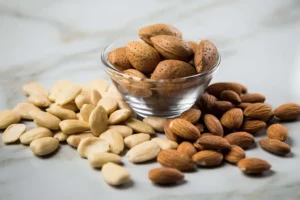
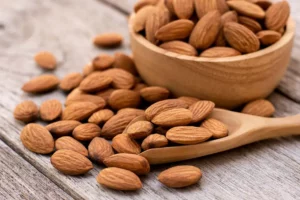

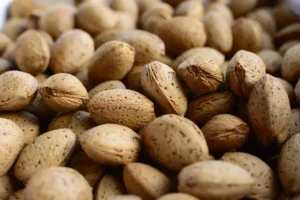
Almond
The word “Almond” comes from old French “almande or allemande” late Latin “Amanda”.
The Almond is a species of tree native to the Middle East and South Asia. Almond is also
the name of the edible and widely cultivated seed of this tree. The almond is often thought
of as a nut, though it’s technically a drupe fruit produced by the almond tree (Prunus
dulcis; Prunus amygdalus).
Types
Mamai Almond
This type of almond includes large kernel, thin skin, stretched appearance, and high resistance to pests. Therefore, it’s one of the best types of almonds in Iran. Moreover, this almond is popular because of its nutrients and unsaturated fat.
Stone Almond
One of the most common types of almonds produced in Iran is stone almonds, it has a hard skin and does not break easily. This type of almond is used in different forms of salted, raw, and sliced. High resistance to dehydration, high amount of fat, and pharmaceutical and cosmetic use are some specifications of this product to name a few.
Paper Skin Almond
Paper skin Almond is one of the luxury almonds due to its fragile skin and is an integral part of the world nuts and nuts.
|
Calories |
164cal |
|
Fat |
14.2g |
|
Sodium |
0.3mg |
|
Carbohydrates |
6.1g |
|
Fiber |
3.5g |
|
Sugars |
1.2g |
|
Protein |
6g |
Almonds are widely promoted for the nutritional and health benefits that they provide. Scientific studies have provided some insights into the ways that consuming almonds may affect human health.
Reduces Risk of Heart Disease
According to a review of 29 studies conducted in 2016, eating 28 grams of nuts per day, as part of a diet low in saturated fat and cholesterol, may reduce the risk of heart disease. When it comes to almonds specifically, this may because they provide lipid-lowering monounsaturated fat, fiber, and vitamin E. Almonds also contain phytonutrients, especially plant sterols and flavonoids, which are heart-healthy and offer antioxidant benefits. To maximize these nutrients, enjoy your almonds with the skins (flavonoids are concentrated there).
Helps Lower Cholesterol
Studies investigating the health benefits of nuts, in general, have pointed out that consuming almonds may help to lower LDL cholesterol levels. Low density lipoproteins are considered “bad cholesterol” because elevated levels are linked to heart disease.
Almond consumption has also been linked to higher HDL cholesterol levels. HDL is considered to be “good cholesterol” because it is instrumental in removing LDL cholesterol from the body. Study authors suggested that almonds could even be a food used in the treatment of people with high cholesterol who do not wish to take or cannot tolerate large doses of medication.
Improves Diabetes Risk and Management
Some studies suggest that higher intakes of magnesium are associated with a reduced risk of developing diabetes. Since almonds provide magnesium, they may provide this benefit. But there is other evidence that supports the consumption of almonds to prevent diabetes.
For instance, a study on adolescents and young adults who were at risk for developing diabetes found that those who consumed 56 grams of almonds daily showed reduced HbA1c, LDL cholesterol, and total cholesterol levels in just 12 weeks. Some studies have also suggested that almond consumption can help those with diabetes control blood sugar and lipid profiles.
Supports Gut Health
A comprehensive research review published in 2021 explored the health benefits of almonds. The study authors pointed out the benefits that nuts provide to the gut microbiota. Specifically, they found that consuming the nuts can support colon health by promoting microflora richness and diversity, improving the ratio of microflora, and boosting concentrations of health-promoting colonic bioactives.
May Provide Metabolic Benefits
That same 2021 research review suggested that almonds may offer metabolic benefits. Specifically, authors found that diets containing almonds helped study participants feel less hungry and more satiated, and increase resting energy expenditure. Compared to other nuts, almonds also helped create small but significant decreases in both body weight and fat mass.
Natural almonds can be stored for two years or more when their freshness and shelf-life is maximized by placing them in the refrigerator or freezer.
Roasted almonds can stay good for up to a year in an airtight container in the refrigerator or freezer.
Almonds should be stored in an airtight container and it’s best to store them in the refrigerator or freezer. Almonds are not recommended to be stored at room temperature for periods of time, so your pantry is not a good idea. However, you can take enough for a day or two out of storage while keeping the rest safe and fresh.
Available Packing:
10kg
25kg
50kg
Grading
Akam Trade has all 8 almond grades: 5A, 4A, 3A, 2A, A, ES, EBS, and Mini. Attention to this table:
|
5A |
Grade 5A is the largest grade of almond. There are 80 to 85 almond kernels per 100 grams. |
|
4A |
Grade 4A is the largest grade of almond. There are 90 to 95 almond kernels per 100 grams. |
|
3A |
Grade 3A is the largest grade of almond. There are 100 to 105 almond kernels per 100 grams. |
|
2A |
Grade 2A is the largest grade of almond. There are 110 to 115 almond kernels per 100 grams. |
|
A |
Grade A is the largest grade of almond. There are 120 to 125 almond kernels per 100 grams. |
|
ES |
Grade ES is the largest grade of almond. There are 130 to 135 almond kernels per 100 grams. |
|
ESB |
Grade 3A is the largest grade of almond. There are 140 to 145 almond kernels per 100 grams. |
|
mini |
Grade mini is the lowest grade of almond. There are 160 or more almond kernels per 100 grams. |
5A
4A
3A
2A
A
ES
ESB
Mini
Process
The almond (Prunus amygdalus, syn. Prunus dulcis) is a species of small tree from the genus Prunus, cultivated worldwide for its seed, a culinary nut. Along with the peach, it is classified in the subgenus Amygdalus, distinguished from the other subgenera by corrugations on the shell (endocarp) surrounding the seed.
The almond is a deciduous tree growing to 4–12.2 metres (13–40 feet) in height,with a trunk of up to 30 centimetres (12 inches) in diameter. The young twigs are green at first, becoming purplish where exposed to sunlight, then gray in their second year. The leaves are 8–13 cm (3–5 in) long,with a serrated margin and a 2.5 cm (1 in) petiole.
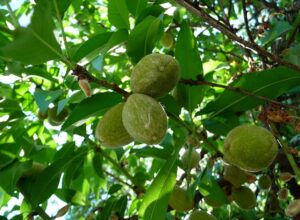
The flowers are white to pale pink, 3–5 cm (1–2 in) diameter with five petals, produced singly or in pairs and appearing before the leaves in early spring.Almond grows best in Mediterranean climates with warm, dry summers and mild, wet winters. The optimal temperature for their growth is between 15 and 30 °C (59 and 86 °F) and the tree buds have a chilling requirement of 200 to 700 hours below 7.2 °C (45.0 °F) to break dormancy.
Almonds begin bearing an economic crop in the third year after planting. Trees reach full bearing five to six years after planting. The fruit matures in the autumn, 7–8 months after flowering.
 The almond fruit is 3.5–6 cm (1+3⁄8–2+3⁄8 in) long. It is not a nut but a drupe. The outer covering, consisting of an outer exocarp, or skin, and mesocarp, or flesh, fleshy in other members of Prunus such as the plum and cherry, is instead a thick, leathery, gray-green coat (with a downy exterior), called the hull. Inside the hull is a woody endocarp which forms a reticulated, hard shell (like the outside of a peach pit) called the pyrena. Inside the shell is the edible seed, commonly called a nut. Generally, one seed is present, but occasionally two occur. After the fruit matures, the hull splits and separates from the shell, and an abscission layer forms between the stem and the fruit so that the fruit can fall from the tree.
The almond fruit is 3.5–6 cm (1+3⁄8–2+3⁄8 in) long. It is not a nut but a drupe. The outer covering, consisting of an outer exocarp, or skin, and mesocarp, or flesh, fleshy in other members of Prunus such as the plum and cherry, is instead a thick, leathery, gray-green coat (with a downy exterior), called the hull. Inside the hull is a woody endocarp which forms a reticulated, hard shell (like the outside of a peach pit) called the pyrena. Inside the shell is the edible seed, commonly called a nut. Generally, one seed is present, but occasionally two occur. After the fruit matures, the hull splits and separates from the shell, and an abscission layer forms between the stem and the fruit so that the fruit can fall from the tree.

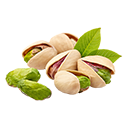 Pistachio
Pistachio Almond
Almond Walnut
Walnut Barberry
Barberry Raisins
Raisins Saffron
Saffron Jujube
Jujube Dried Fig
Dried Fig Kaloote
Kaloote Piarom
Piarom Zahedi
Zahedi Mazafati
Mazafati Estameran
Estameran Rabbi
Rabbi